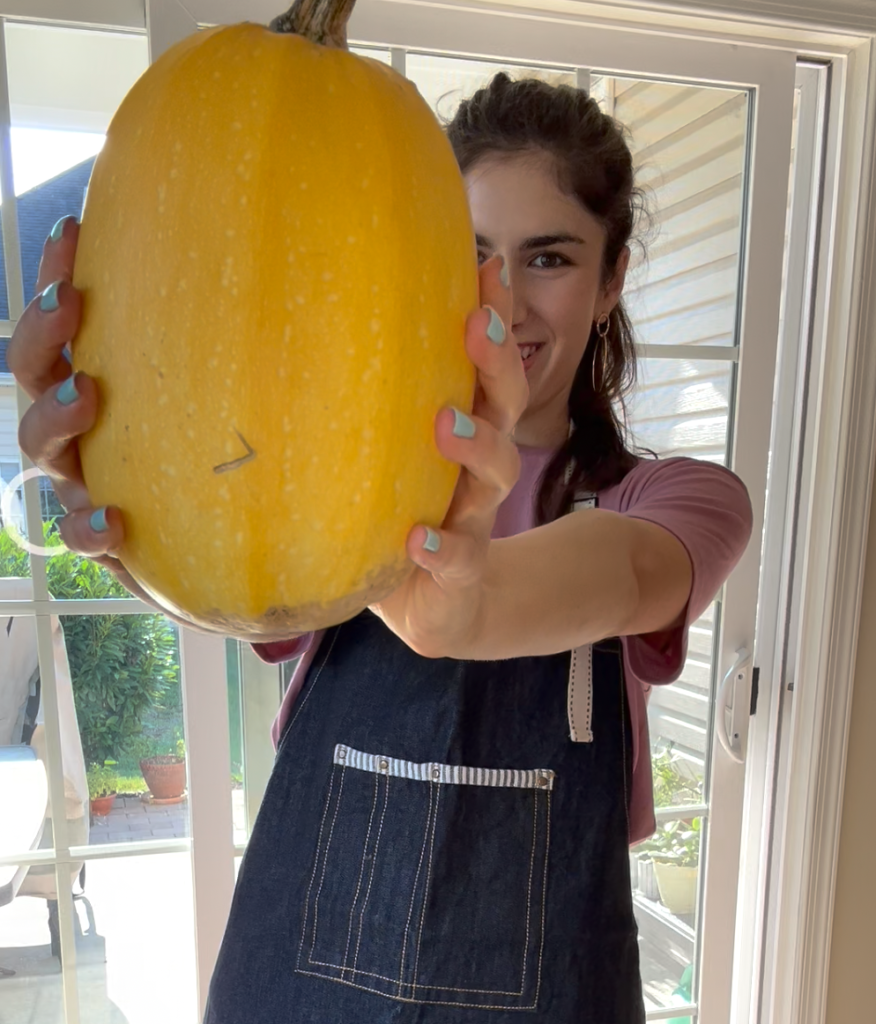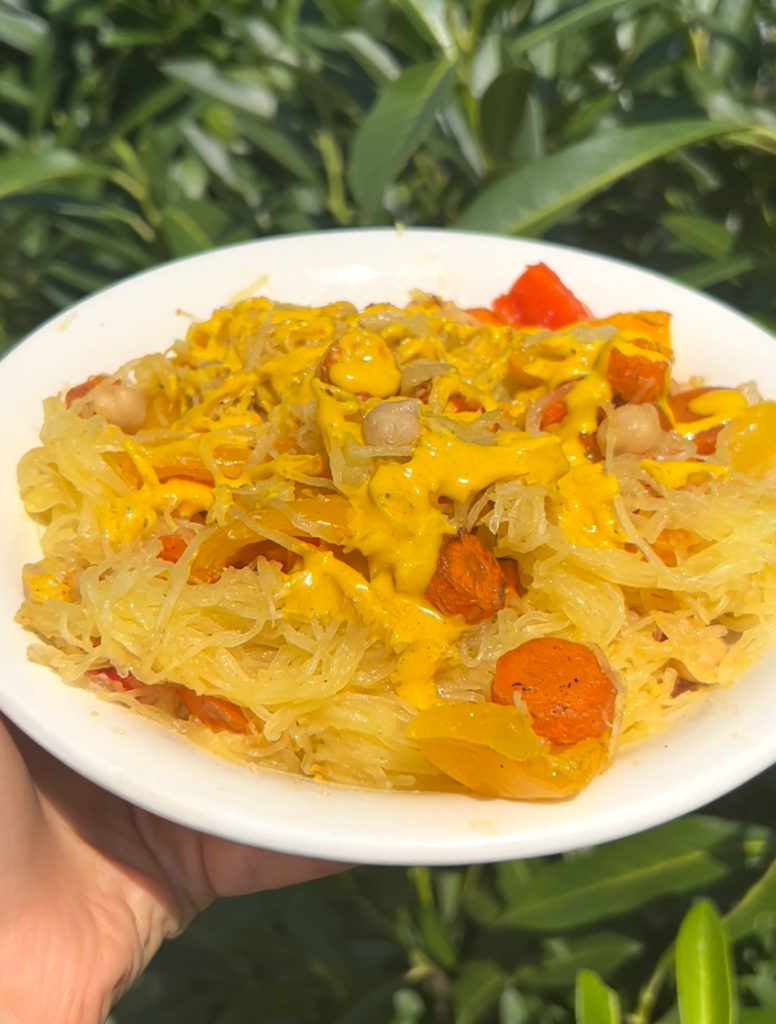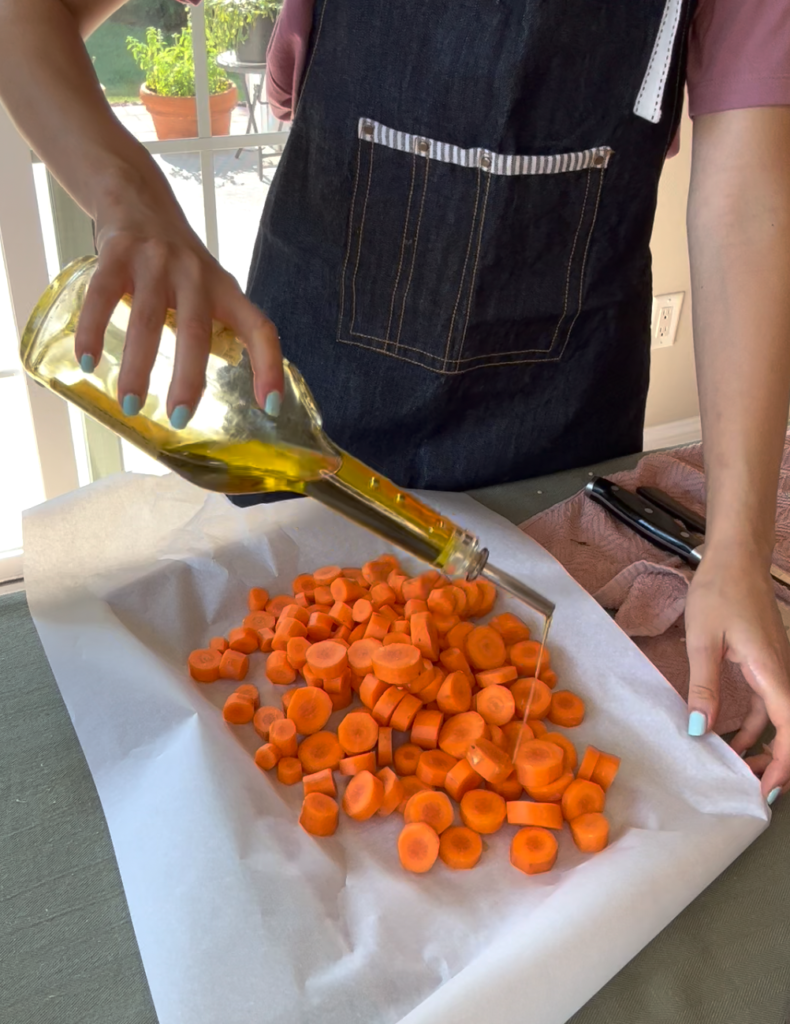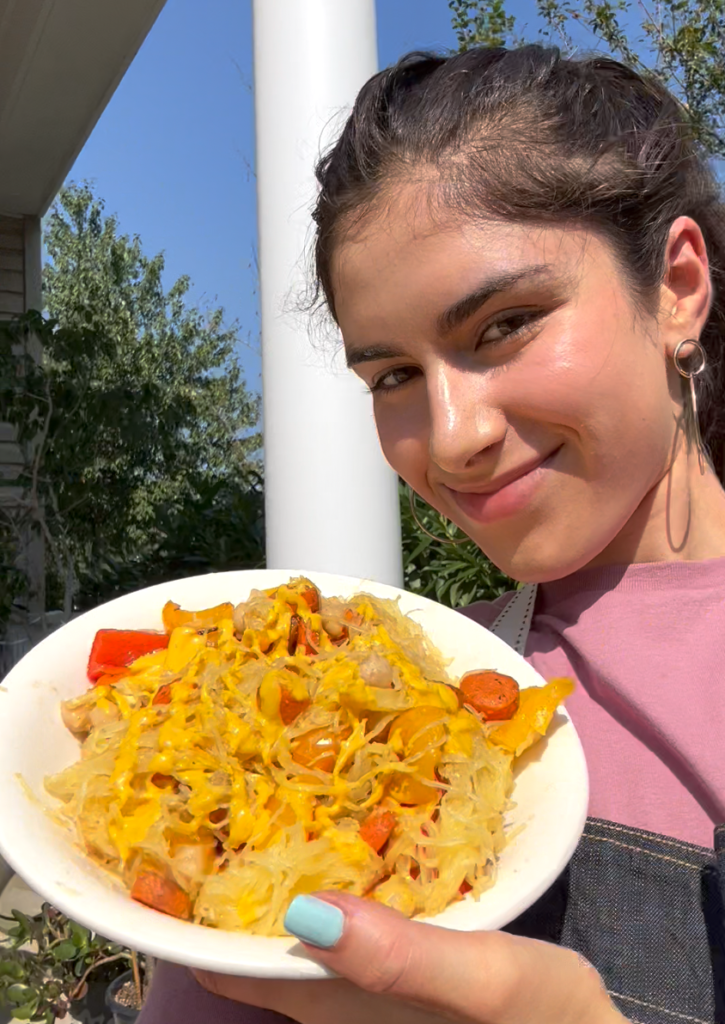Inspired by the dynamic duo of Dr. Roizen and Chef Jim at the Cleveland Clinic, where I interned last summer, I’m embarking on a mission to introduce culinary medicine in an accessible way – through social media. Every Friday, I’ll be sharing a “Functional Foodie” recipe as part of my job as Patient Care Navigator at Princeton Integrative Health.


Last week, one of my dearest patients at the practice surprised me with something: spaghetti squash straight from her garden! I was so touched that within just two weeks of knowing them, they shared what they grew with me. It was a precious offering, so I knew I had to create and name a dish in their honor.
In the past couple days, I’ve been blessed with more of their garden-grown veg – but more on that in the coming weeks. For now, let’s discover what a golden goddess would eat for lunch.
This dish is a fantastic bridge from summer to fall, boasting roasted spaghetti squash, carrots infused with the lively blend of cinnamon, cumin, paprika, and a hint of cayenne, and roasted peppers that bring smoky sweetness to the party. The real beauty here is its adaptability; mix and match the individually roasted vegetables with what you desire, like luscious tofu ricotta, spaghetti aglio e olio, or tah dig. It’s a delicious and versatile way to embrace the changing seasons.


The dressing is a golden elixir, infusing every bite with a creamy, nutty richness and a burst of earthy, vibrant turmeric. It’s not just a dressing, it’s the crowning glory that makes this dish a standout. Simply put, it makes me feel golden. I’ve remade the dressing on its own on several occasions since, adding it to arnabeet mekleh (Lebanese cauliflower) and a falafel bowl.
Let’s munch on this dish – at least nutrition wise – first:
- Spaghetti squash. Look, I’m not trying to replace spaghetti, but the name of this vegetable is quite fitting when it comes to its texture. Spaghetti squash offers numerous health benefits, as it’s low in calories and carbohydrates while providing essential nutrients like vitamin C, potassium, and dietary fiber, making it a valuable addition to a balanced diet (Source: “Spaghetti squash: An unconventional vegetable,” in Comprehensive Reviews in Food Science and Food Safety, 2015).
- Carrots. Carrots are a nutritional powerhouse, renowned for their high beta-carotene content, which the body converts into vitamin A, supporting healthy vision, immune function, and skin health (Source: “Provitamin A Carotenoids and Cancer Prevention: A Meta-analysis” in The American Journal of Clinical Nutrition, 2012). Additionally, their rich antioxidant and dietary fiber content has been associated with a reduced risk of chronic diseases and improved digestive health (Source: “The Role of Carotenoids in Human Health” in The Nutrition in Clinical Care, 2002).
- Red, orange, and yellow bell peppers. Red, orange, and yellow bell peppers are rich sources of carotenoids, such as beta-carotene and lutein, which have been associated with improved eye health and a reduced risk of age-related macular degeneration (Source: “Carotenoids and Eye Health,” Nutrients, 2013). Furthermore, these colorful peppers are high in vitamin C, which acts as a potent antioxidant and supports immune function, making them valuable components of a nutritious diet (Source: “Vitamin C and Immune Function,” Nutrients, 2017).
- Extra virgin olive oil. Olive oil has a smoke point of around 375-410°F (190-210°C), so it’s best suited for roasting at lower to medium temperatures like in this recipe. It contains heart-healthy monounsaturated fats and potent antioxidants like polyphenols, which have been associated with various health benefits when integrated into a balanced diet, including potential anti-inflammatory properties.
- Tip: Use different olive oils for different purposes. For roasting, all you need is a mild flavor and high quality product, like this one. For more specifics on olive oil, check this out.
- Turmeric (and its friend, black pepper). Turmeric contains curcumin, a compound with health-promoting properties, while black pepper contains piperine, a natural enhancer of curcumin absorption in the body. When combined, piperine in black pepper has been shown to significantly increase the bioavailability of curcumin, enhancing its therapeutic potential and making it a powerful combination for health benefits (Source: “Influence of piperine on the pharmacokinetics of curcumin in animals and human volunteers.” by Shoba G et al., Planta Medica, 1998).
- About buying fair-trade, sustainably sourced spices. Purchasing sustainably sourced turmeric is imperative for both environmental conservation and ethical considerations. Unsustainable turmeric farming practices can lead to deforestation, habitat loss, and soil degradation, while responsible sourcing methods prioritize eco-friendly land management and the preservation of biodiversity. Additionally, supporting sustainable turmeric cultivation often entails fair labor practices, ensuring that workers are paid equitably and work in safe conditions, promoting social responsibility and ethical trade. My favorite brand is Burlap & Barrel. Their commitment to single-origin sourcing from smallholder farmers and cooperatives ensures a transparent and ethical supply chain, fostering sustainability and empowering local communities.
- Tahini. Tahini is a nutrient-dense paste derived from sesame seeds, renowned for its richness in essential minerals such as calcium, iron, magnesium, and phosphorus, as well as its high content of unsaturated fats, plant-based protein, and bioactive compounds like lignans (Source: “Chemical Composition and Nutritional Evaluation of Sesame Seed” in Food Chemistry, 2006).
- Chickpeas. Chickpeas and tahini make a nutritionally advantageous combination due to their complementary amino acid profiles. Chickpeas are rich in the essential amino acid lysine but lower in methionine, while tahini is abundant in methionine but relatively lower in lysine. This synergy allows for a more balanced intake of essential amino acids, making it a valuable source of complete plant-based protein with improved protein utilization in the body (Source: “The Protein Digestibility-Corrected Amino Acid Score” in The Journal of Nutrition, 2013).
- Getting specific. A general guideline is to aim for a roughly 3:1 ratio of chickpeas to tahini by weight. As it works out in the servings of this recipe, 1/4 can of chickpeas creates a 3:1 ratio with the respective 1 tbsp of tahini.
Shall we get roastin’?
GOLDEN GODDESS GOODNESS, GF + V
Serves 4
Ingredients
- 12 carrots, chopped in cylinders
- 4 bell peppers, chopped in cubes
- Extra virgin olive oil, as needed
- Salt and sustainably sourced black pepper, as needed
- 1/2 tsp sustainably sourced ground cinnamon
- 1/2 tsp sustainably sourced ground cumin
- 1/2 tsp sustainably sourced paprika
- 1/4 tsp sustainably sourced cayenne
- 2 spaghetti squash, halved
For the golden goddess sauce
- 1/4 cup tahini
- 1/4 cup cold water
- juice 1/2 lemon
- 1 tsp sustainably sourced ground turmeric
- Sustainably sourced black pepper
- 1/2 tsp sustainably sourced paprika
- 1/2 tsp sustainably sourced cumin
- 1/2 tbsp maple syrup (optional)
Protein topping options
- Chickpeas
- Sunny-side-up eggs
- Chicken
- Roasted tofu
How to
- Preheat your oven to 400°F (200°C).
- Clean and chop your peppers into cubes and carrots into cylinders. On one parchment lined pan, put your peppers with a drizzle of olive oil and salt. On another parchment lined pan, put your carrots with a drizzle of olive oil and salt, along with cinnamon, cumin, paprika, and cayenne (optional, but recommended).
- Chop your spaghetti squash lengthwise; I found it easier to chop off the ends first so it was stable. Scoop out the seeds and filling of the squash. Drizzle with olive oil, and season with salt and black pepper. Place them cut side down on a baking sheet (so they’re like domes on your pan). Prick the skin with a fork.
- Place all the pans in the preheated oven. Roast for 40-60 minutes or until the vegetables are tender, checking them halfway through for your desired consistency. The squash should be easily pierced with a fork.
- While the vegetables are roasting, prepare the golden goddess dressing. In a bowl, whisk together tahini, cold water, lemon juice, sustainably sourced turmeric, black pepper, paprika, and cumin. Adjust the consistency by adding more water or tahini as needed. If your tahini is bitter, add in some maple syup.
- Once the spaghetti squash is cooked, let it cool for 10 minutes. Use a fork to shred the flesh into “spaghetti” strands. In a large mixing bowl, combine the roasted vegetables and spaghetti squash. Drizzle the tahini dressing over the top.
- This can be a side to your main meal, but if you’re looking for a one-bowl wonder, I highly recommend adding chickpeas.
Tip: If you have leftovers the next day, I recommend heating up a pan over medium-heat with 1/2 tbsp olive oil. Put in your desired vegetables, and then make two holes and crack two eggs in. Sprinkle with salt and cover with a lid. In about 3-4 minutes, the egg should be cooked, and you’ve got yourself a complete breakfast hash.